Agency Law 2: Commercial Law Report - BULAW1503, 2017
VerifiedAdded on 2020/04/01
|11
|2739
|199
Report
AI Summary
This report provides a detailed analysis of agency law, focusing on the concepts of implied and apparent authority within the context of a commercial law setting. The report begins by addressing a case study involving an agent's actions and their implications for the principal, exploring the issue of whether the agent's work binds the principal based on the authority granted. It delves into the rules of agency law, explaining the principal's liability for the agent's actions and the rationale behind protecting third parties. The report distinguishes between actual and apparent authority, providing examples from cases like Watteau v Fenwick and Freeman and Lockyer v Buckhurst Park Properties (Mangal) Ltd to illustrate these concepts. The application section of the report analyzes the case study, determining the agent's authority, and concluding that the agent possessed both implied and ostensible authority, making the principal liable. The report then shifts to the manner of agency creation, discussing the scope of authority based on how it's granted, differentiating between actual and apparent authority and citing relevant case law to clarify the scope and implications of each type of authority. The report highlights the importance of understanding the nature of agency authority and its impact on the principal's liability towards third parties.

Paraphrase This Document
Need a fresh take? Get an instant paraphrase of this document with our AI Paraphraser
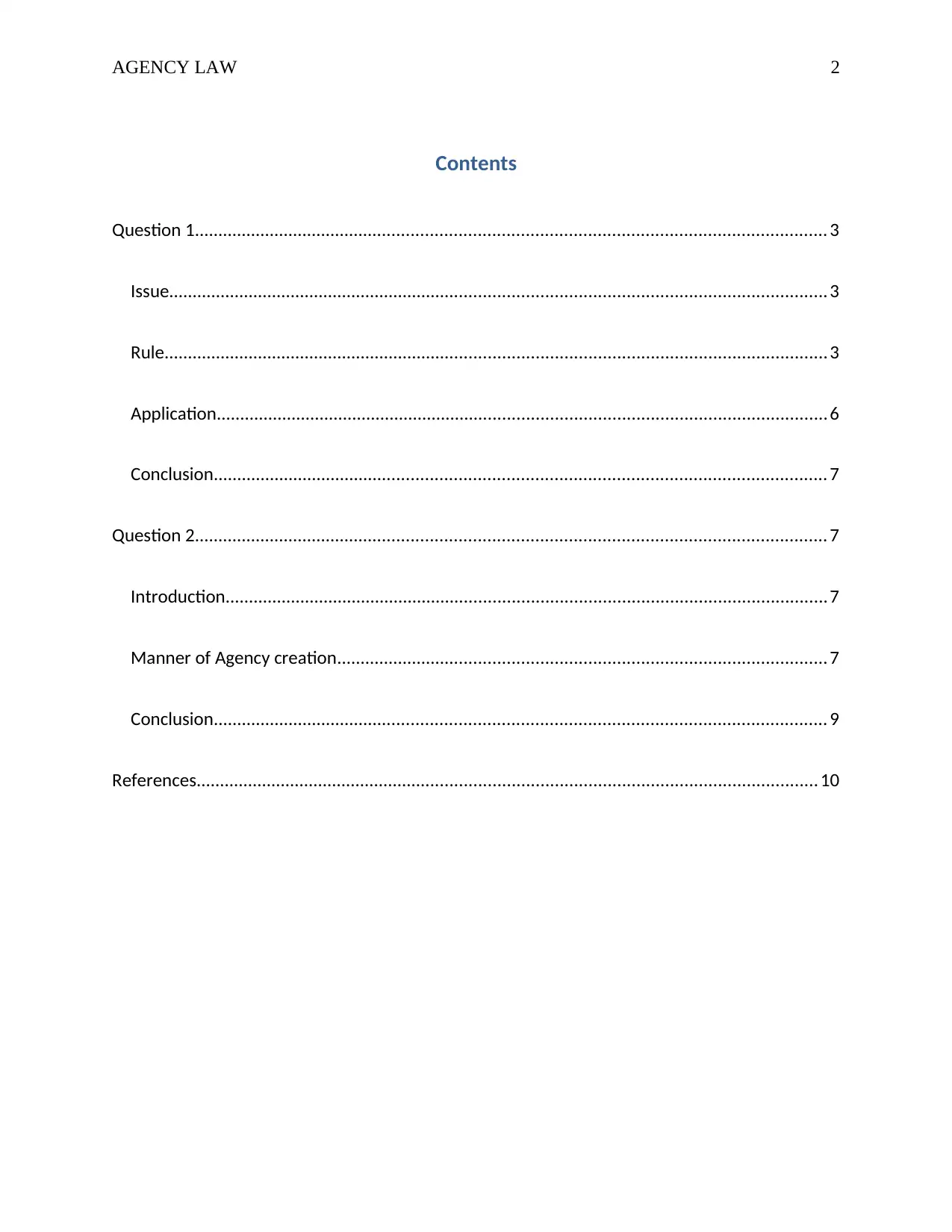
AGENCY LAW 2
Contents
Question 1..................................................................................................................................... 3
Issue........................................................................................................................................... 3
Rule............................................................................................................................................ 3
Application................................................................................................................................. 6
Conclusion................................................................................................................................. 7
Question 2..................................................................................................................................... 7
Introduction...............................................................................................................................7
Manner of Agency creation....................................................................................................... 7
Conclusion................................................................................................................................. 9
References................................................................................................................................... 10
Contents
Question 1..................................................................................................................................... 3
Issue........................................................................................................................................... 3
Rule............................................................................................................................................ 3
Application................................................................................................................................. 6
Conclusion................................................................................................................................. 7
Question 2..................................................................................................................................... 7
Introduction...............................................................................................................................7
Manner of Agency creation....................................................................................................... 7
Conclusion................................................................................................................................. 9
References................................................................................................................................... 10
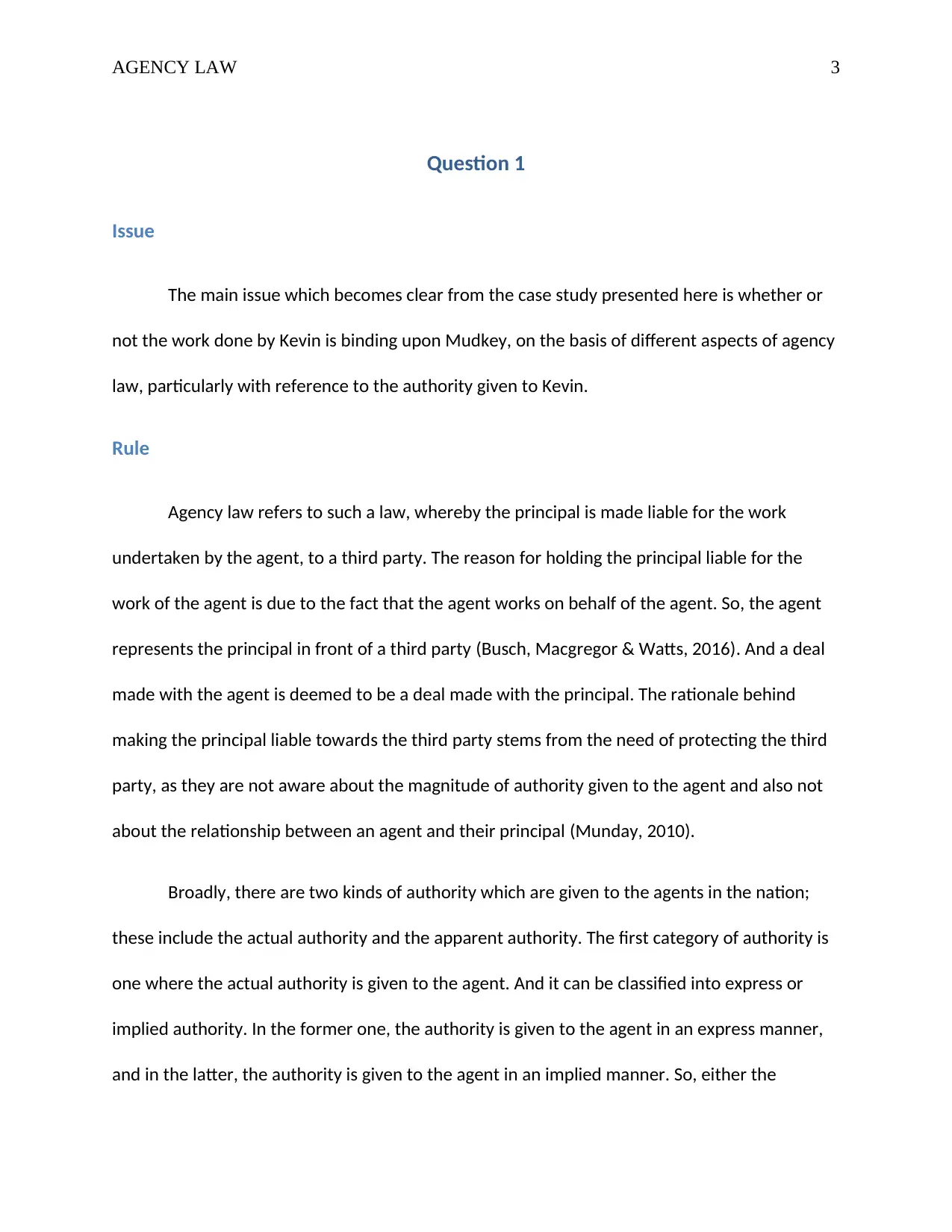
AGENCY LAW 3
Question 1
Issue
The main issue which becomes clear from the case study presented here is whether or
not the work done by Kevin is binding upon Mudkey, on the basis of different aspects of agency
law, particularly with reference to the authority given to Kevin.
Rule
Agency law refers to such a law, whereby the principal is made liable for the work
undertaken by the agent, to a third party. The reason for holding the principal liable for the
work of the agent is due to the fact that the agent works on behalf of the agent. So, the agent
represents the principal in front of a third party (Busch, Macgregor & Watts, 2016). And a deal
made with the agent is deemed to be a deal made with the principal. The rationale behind
making the principal liable towards the third party stems from the need of protecting the third
party, as they are not aware about the magnitude of authority given to the agent and also not
about the relationship between an agent and their principal (Munday, 2010).
Broadly, there are two kinds of authority which are given to the agents in the nation;
these include the actual authority and the apparent authority. The first category of authority is
one where the actual authority is given to the agent. And it can be classified into express or
implied authority. In the former one, the authority is given to the agent in an express manner,
and in the latter, the authority is given to the agent in an implied manner. So, either the
Question 1
Issue
The main issue which becomes clear from the case study presented here is whether or
not the work done by Kevin is binding upon Mudkey, on the basis of different aspects of agency
law, particularly with reference to the authority given to Kevin.
Rule
Agency law refers to such a law, whereby the principal is made liable for the work
undertaken by the agent, to a third party. The reason for holding the principal liable for the
work of the agent is due to the fact that the agent works on behalf of the agent. So, the agent
represents the principal in front of a third party (Busch, Macgregor & Watts, 2016). And a deal
made with the agent is deemed to be a deal made with the principal. The rationale behind
making the principal liable towards the third party stems from the need of protecting the third
party, as they are not aware about the magnitude of authority given to the agent and also not
about the relationship between an agent and their principal (Munday, 2010).
Broadly, there are two kinds of authority which are given to the agents in the nation;
these include the actual authority and the apparent authority. The first category of authority is
one where the actual authority is given to the agent. And it can be classified into express or
implied authority. In the former one, the authority is given to the agent in an express manner,
and in the latter, the authority is given to the agent in an implied manner. So, either the
⊘ This is a preview!⊘
Do you want full access?
Subscribe today to unlock all pages.

Trusted by 1+ million students worldwide
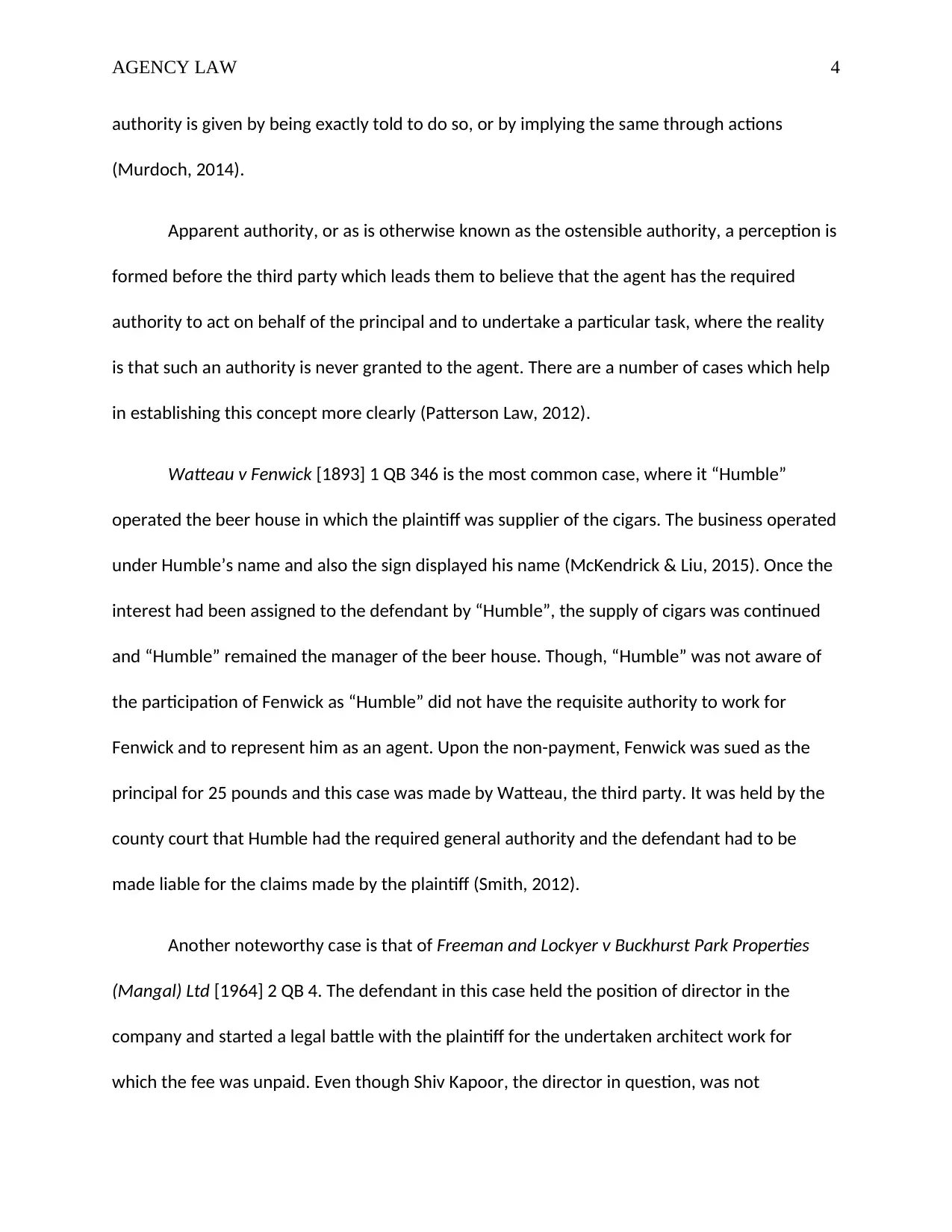
AGENCY LAW 4
authority is given by being exactly told to do so, or by implying the same through actions
(Murdoch, 2014).
Apparent authority, or as is otherwise known as the ostensible authority, a perception is
formed before the third party which leads them to believe that the agent has the required
authority to act on behalf of the principal and to undertake a particular task, where the reality
is that such an authority is never granted to the agent. There are a number of cases which help
in establishing this concept more clearly (Patterson Law, 2012).
Watteau v Fenwick [1893] 1 QB 346 is the most common case, where it “Humble”
operated the beer house in which the plaintiff was supplier of the cigars. The business operated
under Humble’s name and also the sign displayed his name (McKendrick & Liu, 2015). Once the
interest had been assigned to the defendant by “Humble”, the supply of cigars was continued
and “Humble” remained the manager of the beer house. Though, “Humble” was not aware of
the participation of Fenwick as “Humble” did not have the requisite authority to work for
Fenwick and to represent him as an agent. Upon the non-payment, Fenwick was sued as the
principal for 25 pounds and this case was made by Watteau, the third party. It was held by the
county court that Humble had the required general authority and the defendant had to be
made liable for the claims made by the plaintiff (Smith, 2012).
Another noteworthy case is that of Freeman and Lockyer v Buckhurst Park Properties
(Mangal) Ltd [1964] 2 QB 4. The defendant in this case held the position of director in the
company and started a legal battle with the plaintiff for the undertaken architect work for
which the fee was unpaid. Even though Shiv Kapoor, the director in question, was not
authority is given by being exactly told to do so, or by implying the same through actions
(Murdoch, 2014).
Apparent authority, or as is otherwise known as the ostensible authority, a perception is
formed before the third party which leads them to believe that the agent has the required
authority to act on behalf of the principal and to undertake a particular task, where the reality
is that such an authority is never granted to the agent. There are a number of cases which help
in establishing this concept more clearly (Patterson Law, 2012).
Watteau v Fenwick [1893] 1 QB 346 is the most common case, where it “Humble”
operated the beer house in which the plaintiff was supplier of the cigars. The business operated
under Humble’s name and also the sign displayed his name (McKendrick & Liu, 2015). Once the
interest had been assigned to the defendant by “Humble”, the supply of cigars was continued
and “Humble” remained the manager of the beer house. Though, “Humble” was not aware of
the participation of Fenwick as “Humble” did not have the requisite authority to work for
Fenwick and to represent him as an agent. Upon the non-payment, Fenwick was sued as the
principal for 25 pounds and this case was made by Watteau, the third party. It was held by the
county court that Humble had the required general authority and the defendant had to be
made liable for the claims made by the plaintiff (Smith, 2012).
Another noteworthy case is that of Freeman and Lockyer v Buckhurst Park Properties
(Mangal) Ltd [1964] 2 QB 4. The defendant in this case held the position of director in the
company and started a legal battle with the plaintiff for the undertaken architect work for
which the fee was unpaid. Even though Shiv Kapoor, the director in question, was not
Paraphrase This Document
Need a fresh take? Get an instant paraphrase of this document with our AI Paraphraser
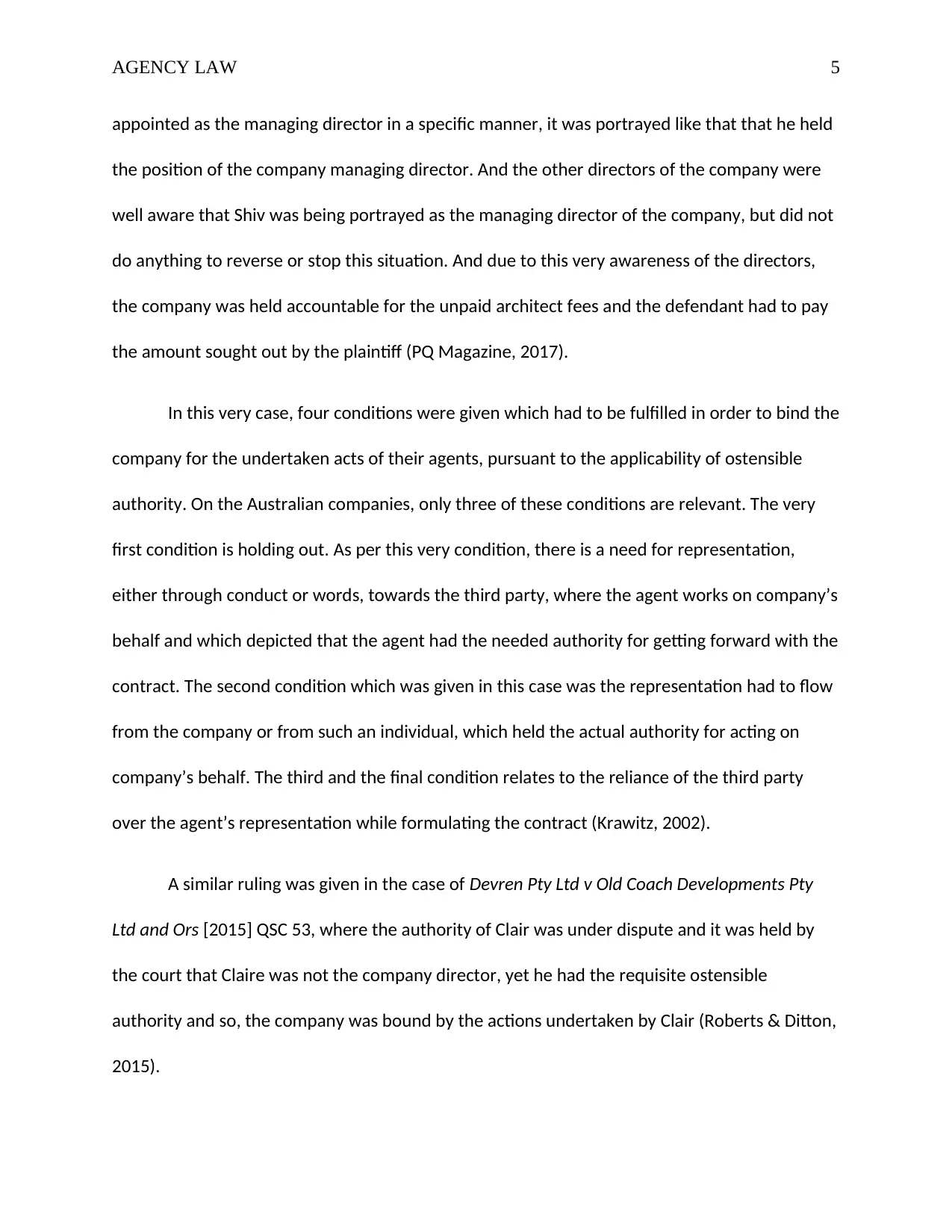
AGENCY LAW 5
appointed as the managing director in a specific manner, it was portrayed like that that he held
the position of the company managing director. And the other directors of the company were
well aware that Shiv was being portrayed as the managing director of the company, but did not
do anything to reverse or stop this situation. And due to this very awareness of the directors,
the company was held accountable for the unpaid architect fees and the defendant had to pay
the amount sought out by the plaintiff (PQ Magazine, 2017).
In this very case, four conditions were given which had to be fulfilled in order to bind the
company for the undertaken acts of their agents, pursuant to the applicability of ostensible
authority. On the Australian companies, only three of these conditions are relevant. The very
first condition is holding out. As per this very condition, there is a need for representation,
either through conduct or words, towards the third party, where the agent works on company’s
behalf and which depicted that the agent had the needed authority for getting forward with the
contract. The second condition which was given in this case was the representation had to flow
from the company or from such an individual, which held the actual authority for acting on
company’s behalf. The third and the final condition relates to the reliance of the third party
over the agent’s representation while formulating the contract (Krawitz, 2002).
A similar ruling was given in the case of Devren Pty Ltd v Old Coach Developments Pty
Ltd and Ors [2015] QSC 53, where the authority of Clair was under dispute and it was held by
the court that Claire was not the company director, yet he had the requisite ostensible
authority and so, the company was bound by the actions undertaken by Clair (Roberts & Ditton,
2015).
appointed as the managing director in a specific manner, it was portrayed like that that he held
the position of the company managing director. And the other directors of the company were
well aware that Shiv was being portrayed as the managing director of the company, but did not
do anything to reverse or stop this situation. And due to this very awareness of the directors,
the company was held accountable for the unpaid architect fees and the defendant had to pay
the amount sought out by the plaintiff (PQ Magazine, 2017).
In this very case, four conditions were given which had to be fulfilled in order to bind the
company for the undertaken acts of their agents, pursuant to the applicability of ostensible
authority. On the Australian companies, only three of these conditions are relevant. The very
first condition is holding out. As per this very condition, there is a need for representation,
either through conduct or words, towards the third party, where the agent works on company’s
behalf and which depicted that the agent had the needed authority for getting forward with the
contract. The second condition which was given in this case was the representation had to flow
from the company or from such an individual, which held the actual authority for acting on
company’s behalf. The third and the final condition relates to the reliance of the third party
over the agent’s representation while formulating the contract (Krawitz, 2002).
A similar ruling was given in the case of Devren Pty Ltd v Old Coach Developments Pty
Ltd and Ors [2015] QSC 53, where the authority of Clair was under dispute and it was held by
the court that Claire was not the company director, yet he had the requisite ostensible
authority and so, the company was bound by the actions undertaken by Clair (Roberts & Ditton,
2015).
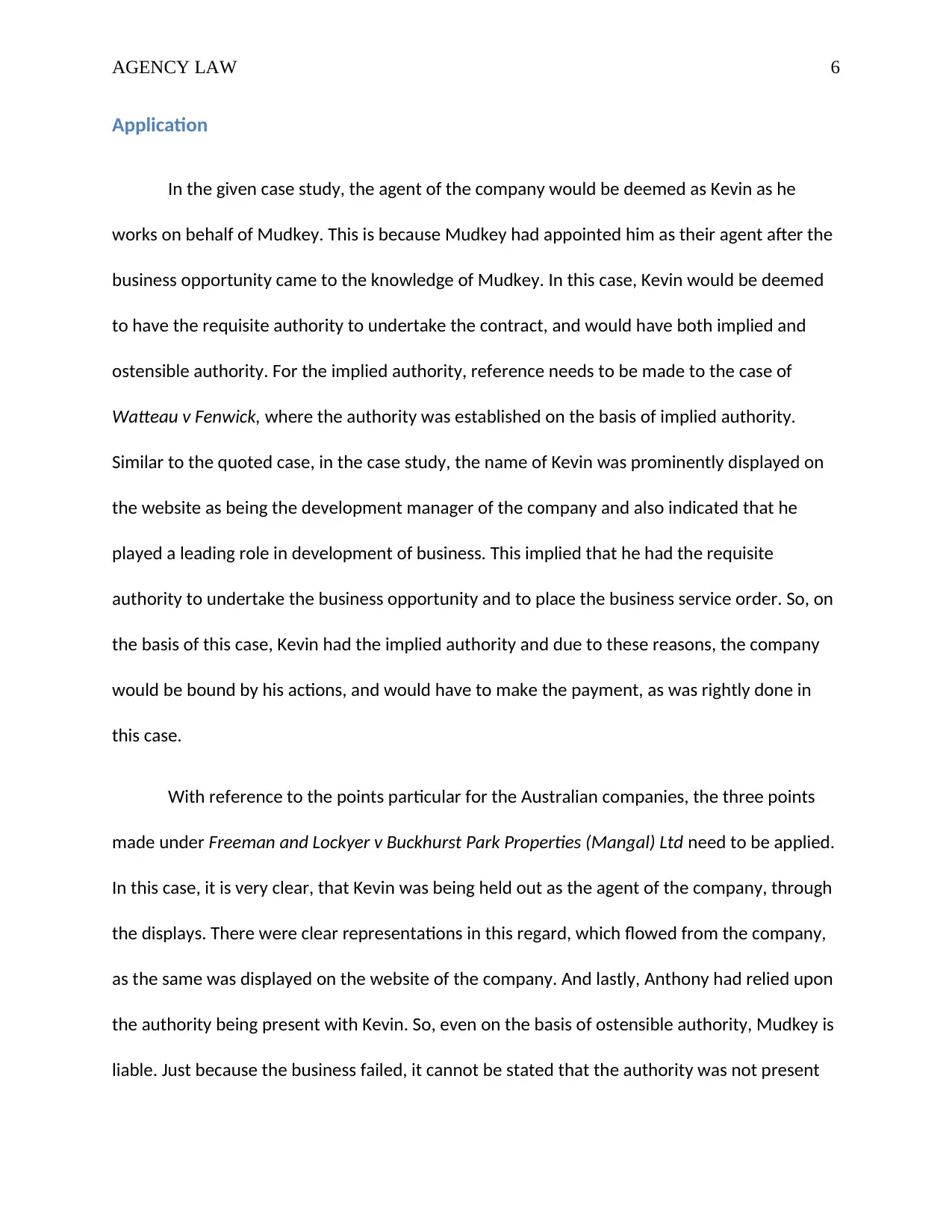
AGENCY LAW 6
Application
In the given case study, the agent of the company would be deemed as Kevin as he
works on behalf of Mudkey. This is because Mudkey had appointed him as their agent after the
business opportunity came to the knowledge of Mudkey. In this case, Kevin would be deemed
to have the requisite authority to undertake the contract, and would have both implied and
ostensible authority. For the implied authority, reference needs to be made to the case of
Watteau v Fenwick, where the authority was established on the basis of implied authority.
Similar to the quoted case, in the case study, the name of Kevin was prominently displayed on
the website as being the development manager of the company and also indicated that he
played a leading role in development of business. This implied that he had the requisite
authority to undertake the business opportunity and to place the business service order. So, on
the basis of this case, Kevin had the implied authority and due to these reasons, the company
would be bound by his actions, and would have to make the payment, as was rightly done in
this case.
With reference to the points particular for the Australian companies, the three points
made under Freeman and Lockyer v Buckhurst Park Properties (Mangal) Ltd need to be applied.
In this case, it is very clear, that Kevin was being held out as the agent of the company, through
the displays. There were clear representations in this regard, which flowed from the company,
as the same was displayed on the website of the company. And lastly, Anthony had relied upon
the authority being present with Kevin. So, even on the basis of ostensible authority, Mudkey is
liable. Just because the business failed, it cannot be stated that the authority was not present
Application
In the given case study, the agent of the company would be deemed as Kevin as he
works on behalf of Mudkey. This is because Mudkey had appointed him as their agent after the
business opportunity came to the knowledge of Mudkey. In this case, Kevin would be deemed
to have the requisite authority to undertake the contract, and would have both implied and
ostensible authority. For the implied authority, reference needs to be made to the case of
Watteau v Fenwick, where the authority was established on the basis of implied authority.
Similar to the quoted case, in the case study, the name of Kevin was prominently displayed on
the website as being the development manager of the company and also indicated that he
played a leading role in development of business. This implied that he had the requisite
authority to undertake the business opportunity and to place the business service order. So, on
the basis of this case, Kevin had the implied authority and due to these reasons, the company
would be bound by his actions, and would have to make the payment, as was rightly done in
this case.
With reference to the points particular for the Australian companies, the three points
made under Freeman and Lockyer v Buckhurst Park Properties (Mangal) Ltd need to be applied.
In this case, it is very clear, that Kevin was being held out as the agent of the company, through
the displays. There were clear representations in this regard, which flowed from the company,
as the same was displayed on the website of the company. And lastly, Anthony had relied upon
the authority being present with Kevin. So, even on the basis of ostensible authority, Mudkey is
liable. Just because the business failed, it cannot be stated that the authority was not present
⊘ This is a preview!⊘
Do you want full access?
Subscribe today to unlock all pages.

Trusted by 1+ million students worldwide
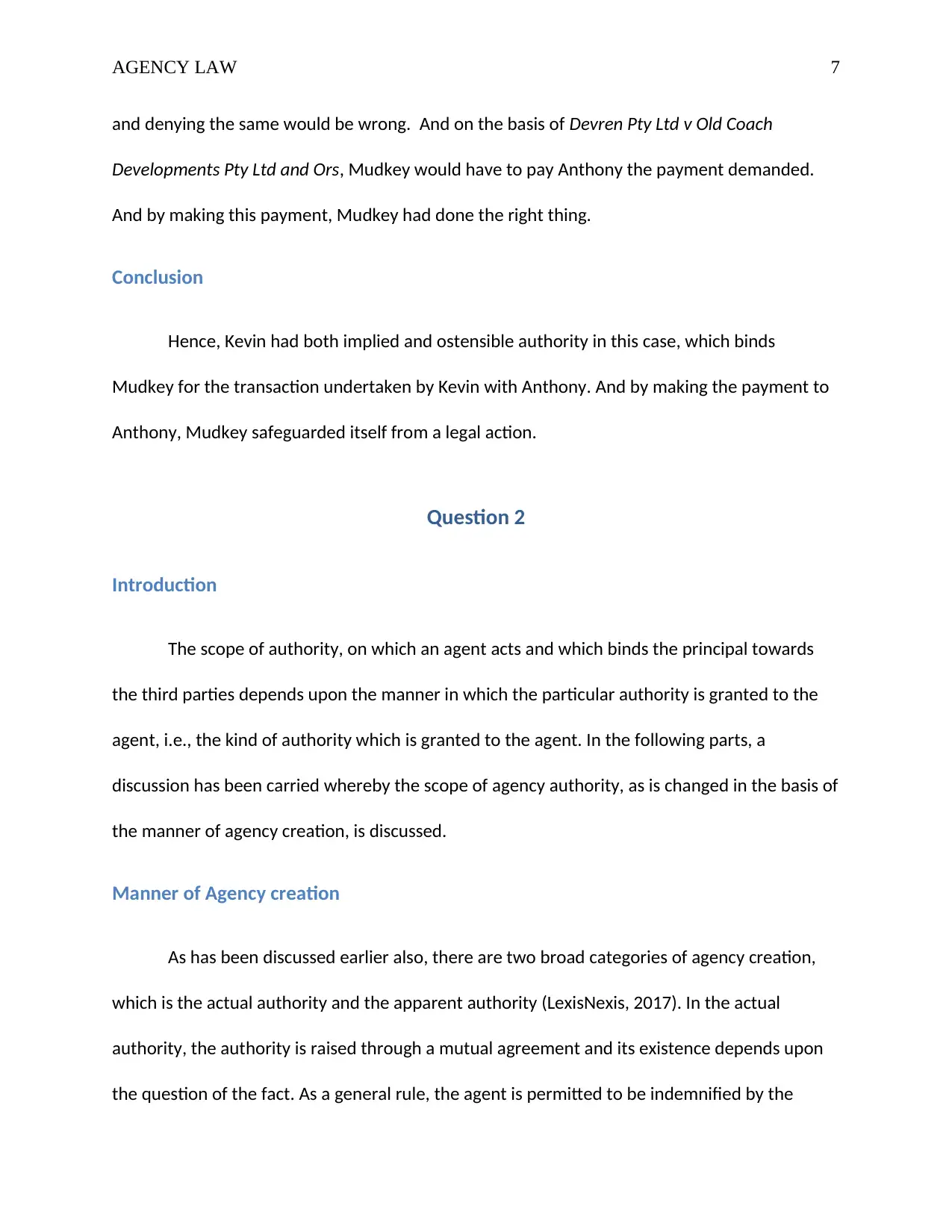
AGENCY LAW 7
and denying the same would be wrong. And on the basis of Devren Pty Ltd v Old Coach
Developments Pty Ltd and Ors, Mudkey would have to pay Anthony the payment demanded.
And by making this payment, Mudkey had done the right thing.
Conclusion
Hence, Kevin had both implied and ostensible authority in this case, which binds
Mudkey for the transaction undertaken by Kevin with Anthony. And by making the payment to
Anthony, Mudkey safeguarded itself from a legal action.
Question 2
Introduction
The scope of authority, on which an agent acts and which binds the principal towards
the third parties depends upon the manner in which the particular authority is granted to the
agent, i.e., the kind of authority which is granted to the agent. In the following parts, a
discussion has been carried whereby the scope of agency authority, as is changed in the basis of
the manner of agency creation, is discussed.
Manner of Agency creation
As has been discussed earlier also, there are two broad categories of agency creation,
which is the actual authority and the apparent authority (LexisNexis, 2017). In the actual
authority, the authority is raised through a mutual agreement and its existence depends upon
the question of the fact. As a general rule, the agent is permitted to be indemnified by the
and denying the same would be wrong. And on the basis of Devren Pty Ltd v Old Coach
Developments Pty Ltd and Ors, Mudkey would have to pay Anthony the payment demanded.
And by making this payment, Mudkey had done the right thing.
Conclusion
Hence, Kevin had both implied and ostensible authority in this case, which binds
Mudkey for the transaction undertaken by Kevin with Anthony. And by making the payment to
Anthony, Mudkey safeguarded itself from a legal action.
Question 2
Introduction
The scope of authority, on which an agent acts and which binds the principal towards
the third parties depends upon the manner in which the particular authority is granted to the
agent, i.e., the kind of authority which is granted to the agent. In the following parts, a
discussion has been carried whereby the scope of agency authority, as is changed in the basis of
the manner of agency creation, is discussed.
Manner of Agency creation
As has been discussed earlier also, there are two broad categories of agency creation,
which is the actual authority and the apparent authority (LexisNexis, 2017). In the actual
authority, the authority is raised through a mutual agreement and its existence depends upon
the question of the fact. As a general rule, the agent is permitted to be indemnified by the
Paraphrase This Document
Need a fresh take? Get an instant paraphrase of this document with our AI Paraphraser
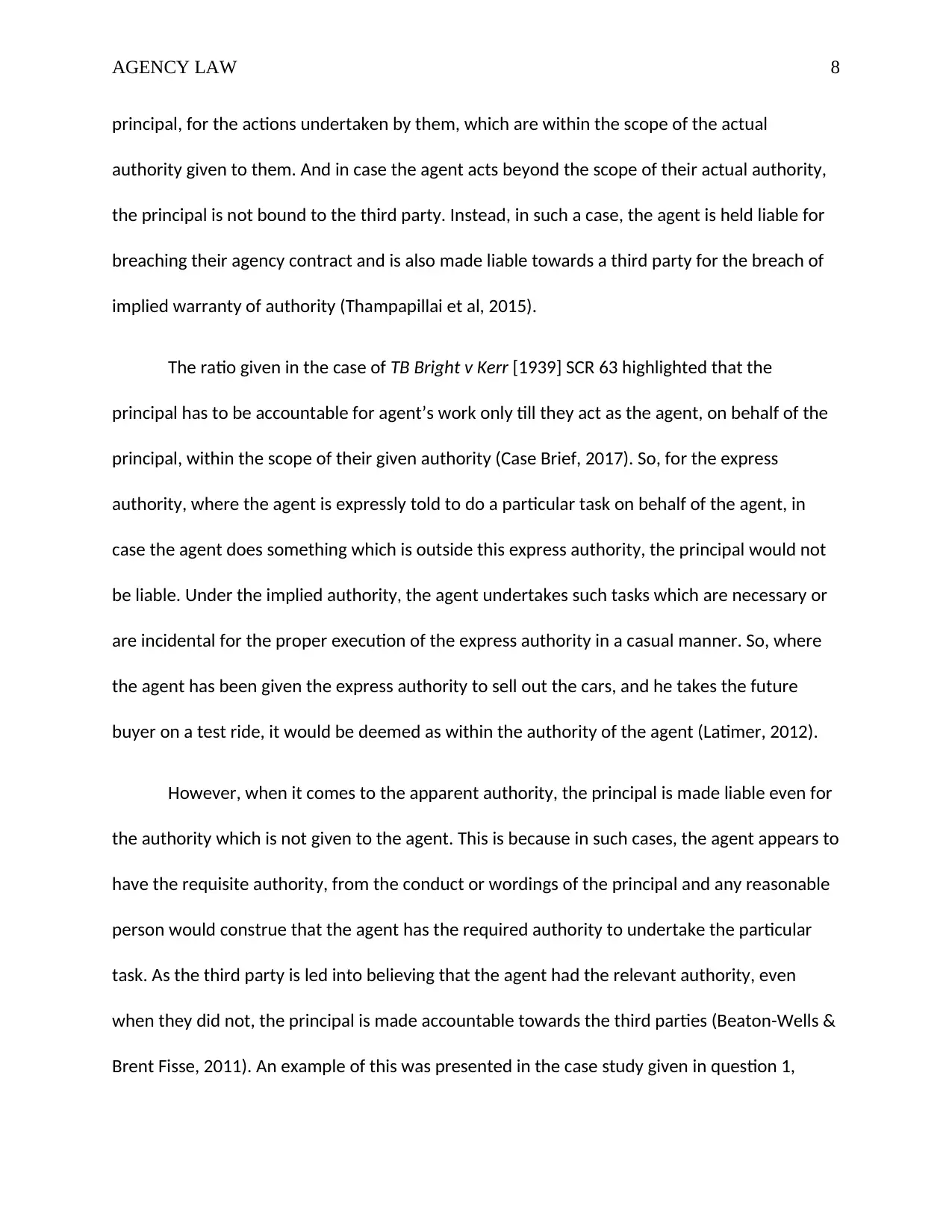
AGENCY LAW 8
principal, for the actions undertaken by them, which are within the scope of the actual
authority given to them. And in case the agent acts beyond the scope of their actual authority,
the principal is not bound to the third party. Instead, in such a case, the agent is held liable for
breaching their agency contract and is also made liable towards a third party for the breach of
implied warranty of authority (Thampapillai et al, 2015).
The ratio given in the case of TB Bright v Kerr [1939] SCR 63 highlighted that the
principal has to be accountable for agent’s work only till they act as the agent, on behalf of the
principal, within the scope of their given authority (Case Brief, 2017). So, for the express
authority, where the agent is expressly told to do a particular task on behalf of the agent, in
case the agent does something which is outside this express authority, the principal would not
be liable. Under the implied authority, the agent undertakes such tasks which are necessary or
are incidental for the proper execution of the express authority in a casual manner. So, where
the agent has been given the express authority to sell out the cars, and he takes the future
buyer on a test ride, it would be deemed as within the authority of the agent (Latimer, 2012).
However, when it comes to the apparent authority, the principal is made liable even for
the authority which is not given to the agent. This is because in such cases, the agent appears to
have the requisite authority, from the conduct or wordings of the principal and any reasonable
person would construe that the agent has the required authority to undertake the particular
task. As the third party is led into believing that the agent had the relevant authority, even
when they did not, the principal is made accountable towards the third parties (Beaton-Wells &
Brent Fisse, 2011). An example of this was presented in the case study given in question 1,
principal, for the actions undertaken by them, which are within the scope of the actual
authority given to them. And in case the agent acts beyond the scope of their actual authority,
the principal is not bound to the third party. Instead, in such a case, the agent is held liable for
breaching their agency contract and is also made liable towards a third party for the breach of
implied warranty of authority (Thampapillai et al, 2015).
The ratio given in the case of TB Bright v Kerr [1939] SCR 63 highlighted that the
principal has to be accountable for agent’s work only till they act as the agent, on behalf of the
principal, within the scope of their given authority (Case Brief, 2017). So, for the express
authority, where the agent is expressly told to do a particular task on behalf of the agent, in
case the agent does something which is outside this express authority, the principal would not
be liable. Under the implied authority, the agent undertakes such tasks which are necessary or
are incidental for the proper execution of the express authority in a casual manner. So, where
the agent has been given the express authority to sell out the cars, and he takes the future
buyer on a test ride, it would be deemed as within the authority of the agent (Latimer, 2012).
However, when it comes to the apparent authority, the principal is made liable even for
the authority which is not given to the agent. This is because in such cases, the agent appears to
have the requisite authority, from the conduct or wordings of the principal and any reasonable
person would construe that the agent has the required authority to undertake the particular
task. As the third party is led into believing that the agent had the relevant authority, even
when they did not, the principal is made accountable towards the third parties (Beaton-Wells &
Brent Fisse, 2011). An example of this was presented in the case study given in question 1,
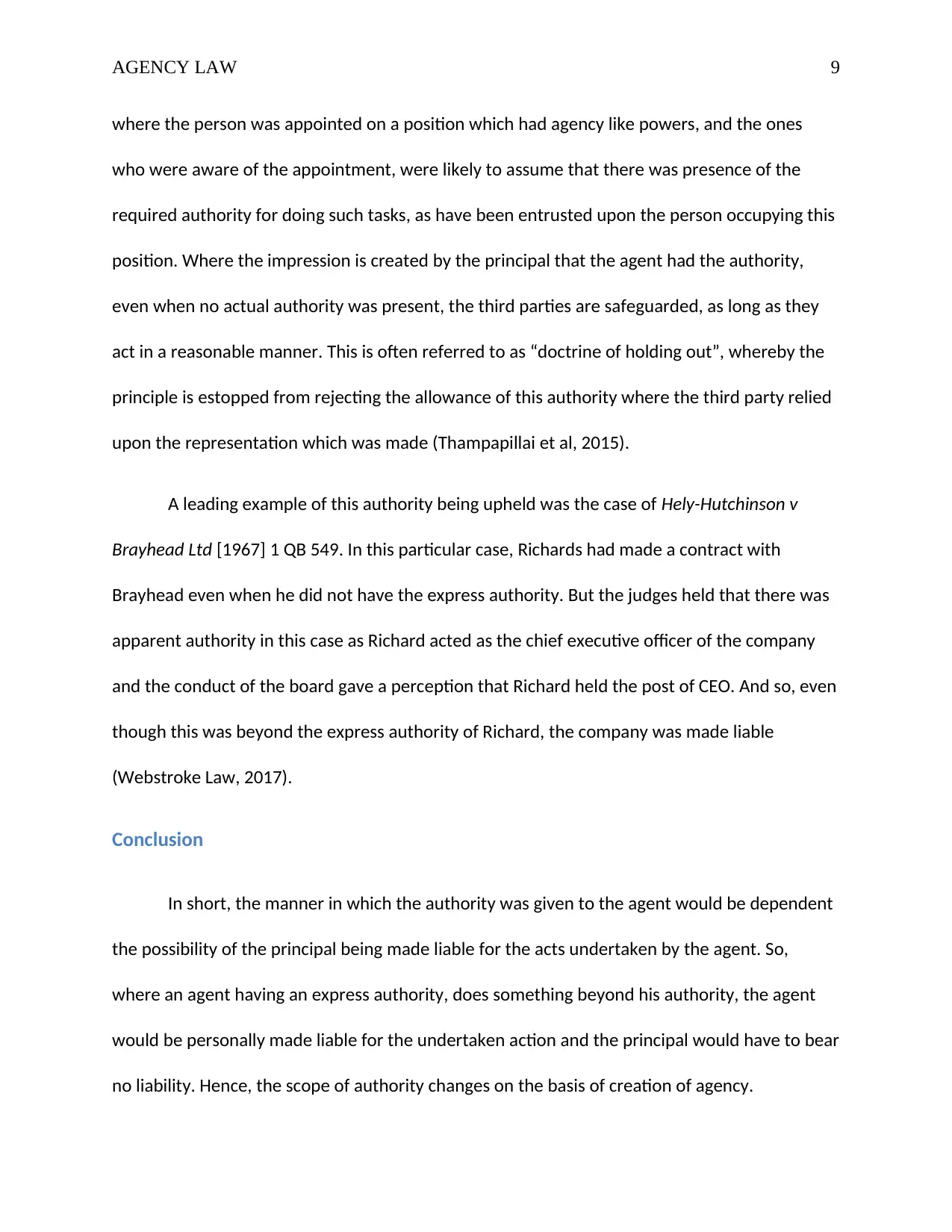
AGENCY LAW 9
where the person was appointed on a position which had agency like powers, and the ones
who were aware of the appointment, were likely to assume that there was presence of the
required authority for doing such tasks, as have been entrusted upon the person occupying this
position. Where the impression is created by the principal that the agent had the authority,
even when no actual authority was present, the third parties are safeguarded, as long as they
act in a reasonable manner. This is often referred to as “doctrine of holding out”, whereby the
principle is estopped from rejecting the allowance of this authority where the third party relied
upon the representation which was made (Thampapillai et al, 2015).
A leading example of this authority being upheld was the case of Hely-Hutchinson v
Brayhead Ltd [1967] 1 QB 549. In this particular case, Richards had made a contract with
Brayhead even when he did not have the express authority. But the judges held that there was
apparent authority in this case as Richard acted as the chief executive officer of the company
and the conduct of the board gave a perception that Richard held the post of CEO. And so, even
though this was beyond the express authority of Richard, the company was made liable
(Webstroke Law, 2017).
Conclusion
In short, the manner in which the authority was given to the agent would be dependent
the possibility of the principal being made liable for the acts undertaken by the agent. So,
where an agent having an express authority, does something beyond his authority, the agent
would be personally made liable for the undertaken action and the principal would have to bear
no liability. Hence, the scope of authority changes on the basis of creation of agency.
where the person was appointed on a position which had agency like powers, and the ones
who were aware of the appointment, were likely to assume that there was presence of the
required authority for doing such tasks, as have been entrusted upon the person occupying this
position. Where the impression is created by the principal that the agent had the authority,
even when no actual authority was present, the third parties are safeguarded, as long as they
act in a reasonable manner. This is often referred to as “doctrine of holding out”, whereby the
principle is estopped from rejecting the allowance of this authority where the third party relied
upon the representation which was made (Thampapillai et al, 2015).
A leading example of this authority being upheld was the case of Hely-Hutchinson v
Brayhead Ltd [1967] 1 QB 549. In this particular case, Richards had made a contract with
Brayhead even when he did not have the express authority. But the judges held that there was
apparent authority in this case as Richard acted as the chief executive officer of the company
and the conduct of the board gave a perception that Richard held the post of CEO. And so, even
though this was beyond the express authority of Richard, the company was made liable
(Webstroke Law, 2017).
Conclusion
In short, the manner in which the authority was given to the agent would be dependent
the possibility of the principal being made liable for the acts undertaken by the agent. So,
where an agent having an express authority, does something beyond his authority, the agent
would be personally made liable for the undertaken action and the principal would have to bear
no liability. Hence, the scope of authority changes on the basis of creation of agency.
⊘ This is a preview!⊘
Do you want full access?
Subscribe today to unlock all pages.

Trusted by 1+ million students worldwide
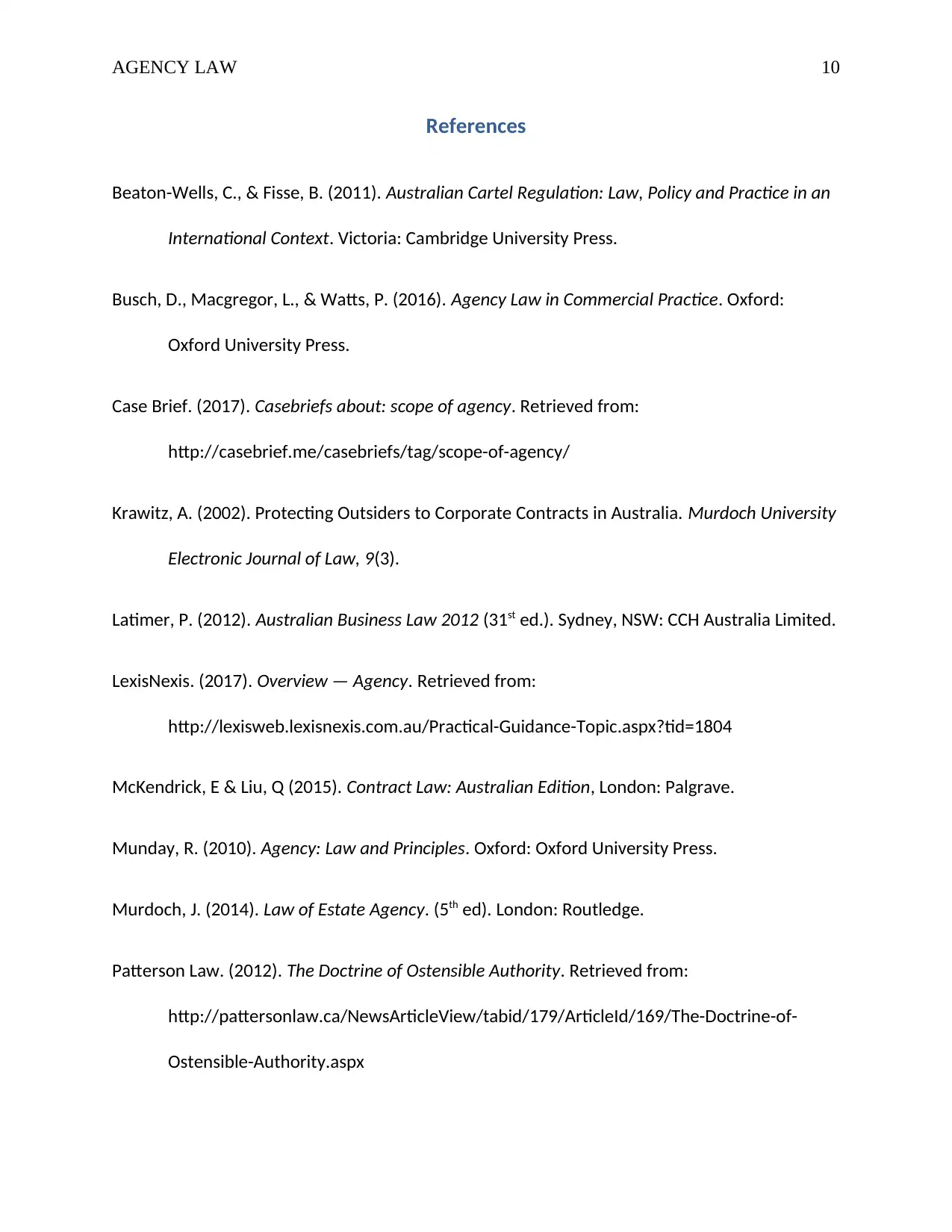
AGENCY LAW 10
References
Beaton-Wells, C., & Fisse, B. (2011). Australian Cartel Regulation: Law, Policy and Practice in an
International Context. Victoria: Cambridge University Press.
Busch, D., Macgregor, L., & Watts, P. (2016). Agency Law in Commercial Practice. Oxford:
Oxford University Press.
Case Brief. (2017). Casebriefs about: scope of agency. Retrieved from:
http://casebrief.me/casebriefs/tag/scope-of-agency/
Krawitz, A. (2002). Protecting Outsiders to Corporate Contracts in Australia. Murdoch University
Electronic Journal of Law, 9(3).
Latimer, P. (2012). Australian Business Law 2012 (31st ed.). Sydney, NSW: CCH Australia Limited.
LexisNexis. (2017). Overview — Agency. Retrieved from:
http://lexisweb.lexisnexis.com.au/Practical-Guidance-Topic.aspx?tid=1804
McKendrick, E & Liu, Q (2015). Contract Law: Australian Edition, London: Palgrave.
Munday, R. (2010). Agency: Law and Principles. Oxford: Oxford University Press.
Murdoch, J. (2014). Law of Estate Agency. (5th ed). London: Routledge.
Patterson Law. (2012). The Doctrine of Ostensible Authority. Retrieved from:
http://pattersonlaw.ca/NewsArticleView/tabid/179/ArticleId/169/The-Doctrine-of-
Ostensible-Authority.aspx
References
Beaton-Wells, C., & Fisse, B. (2011). Australian Cartel Regulation: Law, Policy and Practice in an
International Context. Victoria: Cambridge University Press.
Busch, D., Macgregor, L., & Watts, P. (2016). Agency Law in Commercial Practice. Oxford:
Oxford University Press.
Case Brief. (2017). Casebriefs about: scope of agency. Retrieved from:
http://casebrief.me/casebriefs/tag/scope-of-agency/
Krawitz, A. (2002). Protecting Outsiders to Corporate Contracts in Australia. Murdoch University
Electronic Journal of Law, 9(3).
Latimer, P. (2012). Australian Business Law 2012 (31st ed.). Sydney, NSW: CCH Australia Limited.
LexisNexis. (2017). Overview — Agency. Retrieved from:
http://lexisweb.lexisnexis.com.au/Practical-Guidance-Topic.aspx?tid=1804
McKendrick, E & Liu, Q (2015). Contract Law: Australian Edition, London: Palgrave.
Munday, R. (2010). Agency: Law and Principles. Oxford: Oxford University Press.
Murdoch, J. (2014). Law of Estate Agency. (5th ed). London: Routledge.
Patterson Law. (2012). The Doctrine of Ostensible Authority. Retrieved from:
http://pattersonlaw.ca/NewsArticleView/tabid/179/ArticleId/169/The-Doctrine-of-
Ostensible-Authority.aspx
Paraphrase This Document
Need a fresh take? Get an instant paraphrase of this document with our AI Paraphraser
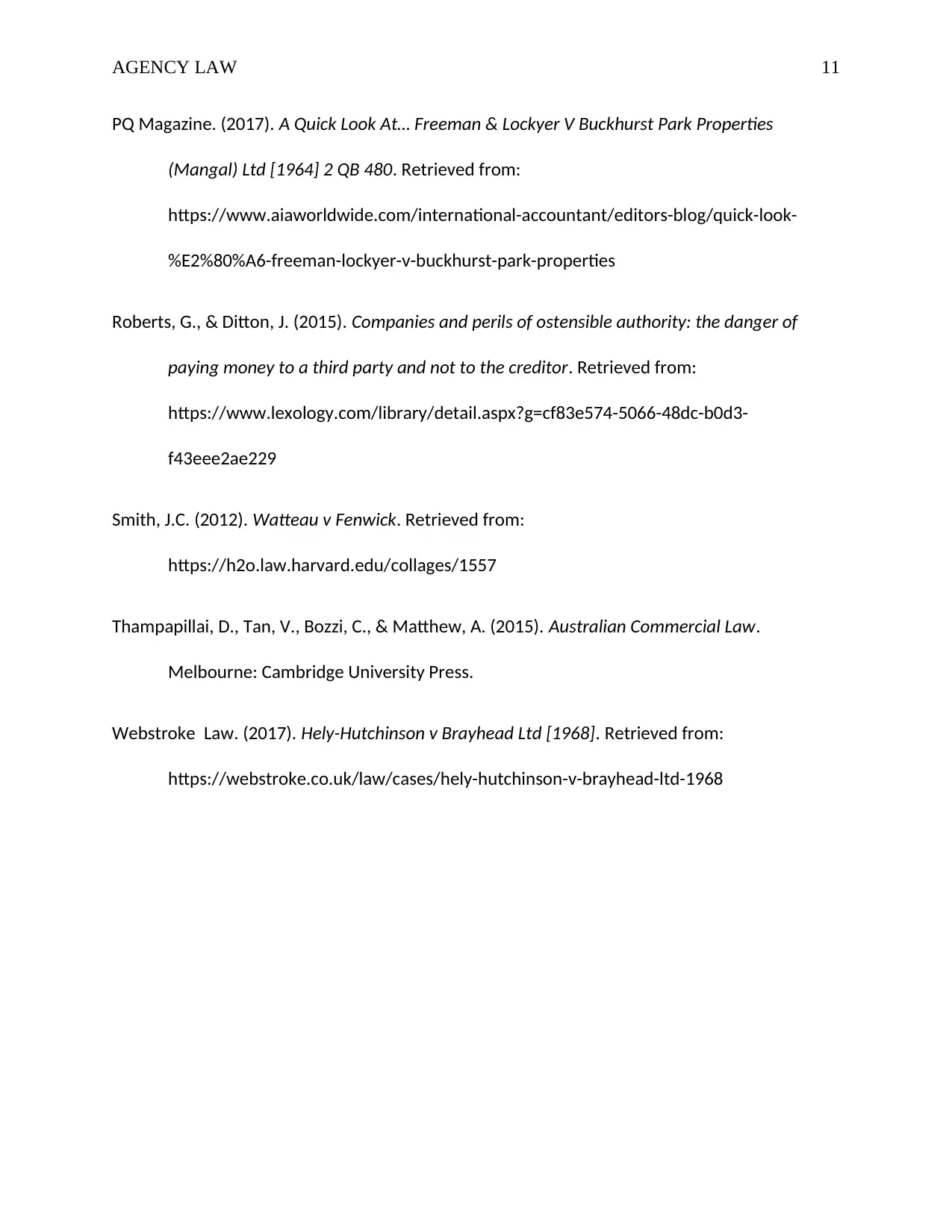
AGENCY LAW 11
PQ Magazine. (2017). A Quick Look At… Freeman & Lockyer V Buckhurst Park Properties
(Mangal) Ltd [1964] 2 QB 480. Retrieved from:
https://www.aiaworldwide.com/international-accountant/editors-blog/quick-look-
%E2%80%A6-freeman-lockyer-v-buckhurst-park-properties
Roberts, G., & Ditton, J. (2015). Companies and perils of ostensible authority: the danger of
paying money to a third party and not to the creditor. Retrieved from:
https://www.lexology.com/library/detail.aspx?g=cf83e574-5066-48dc-b0d3-
f43eee2ae229
Smith, J.C. (2012). Watteau v Fenwick. Retrieved from:
https://h2o.law.harvard.edu/collages/1557
Thampapillai, D., Tan, V., Bozzi, C., & Matthew, A. (2015). Australian Commercial Law.
Melbourne: Cambridge University Press.
Webstroke Law. (2017). Hely-Hutchinson v Brayhead Ltd [1968]. Retrieved from:
https://webstroke.co.uk/law/cases/hely-hutchinson-v-brayhead-ltd-1968
PQ Magazine. (2017). A Quick Look At… Freeman & Lockyer V Buckhurst Park Properties
(Mangal) Ltd [1964] 2 QB 480. Retrieved from:
https://www.aiaworldwide.com/international-accountant/editors-blog/quick-look-
%E2%80%A6-freeman-lockyer-v-buckhurst-park-properties
Roberts, G., & Ditton, J. (2015). Companies and perils of ostensible authority: the danger of
paying money to a third party and not to the creditor. Retrieved from:
https://www.lexology.com/library/detail.aspx?g=cf83e574-5066-48dc-b0d3-
f43eee2ae229
Smith, J.C. (2012). Watteau v Fenwick. Retrieved from:
https://h2o.law.harvard.edu/collages/1557
Thampapillai, D., Tan, V., Bozzi, C., & Matthew, A. (2015). Australian Commercial Law.
Melbourne: Cambridge University Press.
Webstroke Law. (2017). Hely-Hutchinson v Brayhead Ltd [1968]. Retrieved from:
https://webstroke.co.uk/law/cases/hely-hutchinson-v-brayhead-ltd-1968
1 out of 11
Related Documents
Your All-in-One AI-Powered Toolkit for Academic Success.
+13062052269
info@desklib.com
Available 24*7 on WhatsApp / Email
![[object Object]](/_next/static/media/star-bottom.7253800d.svg)
Unlock your academic potential
Copyright © 2020–2025 A2Z Services. All Rights Reserved. Developed and managed by ZUCOL.




